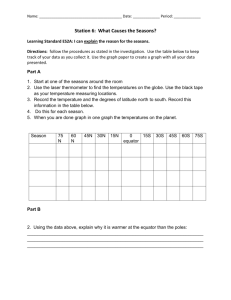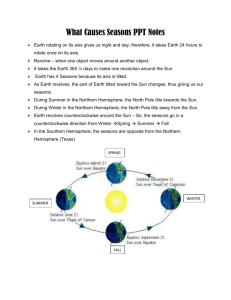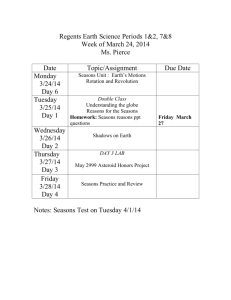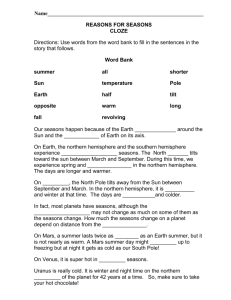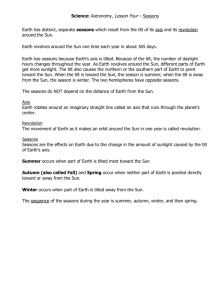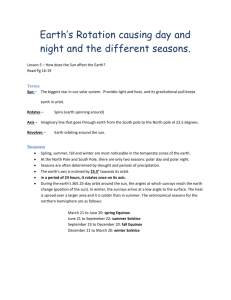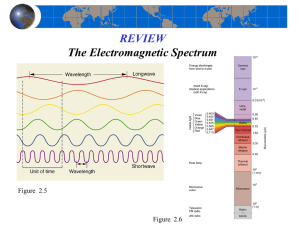Lecture 2 Seasons of the Year Dimensions and Distances
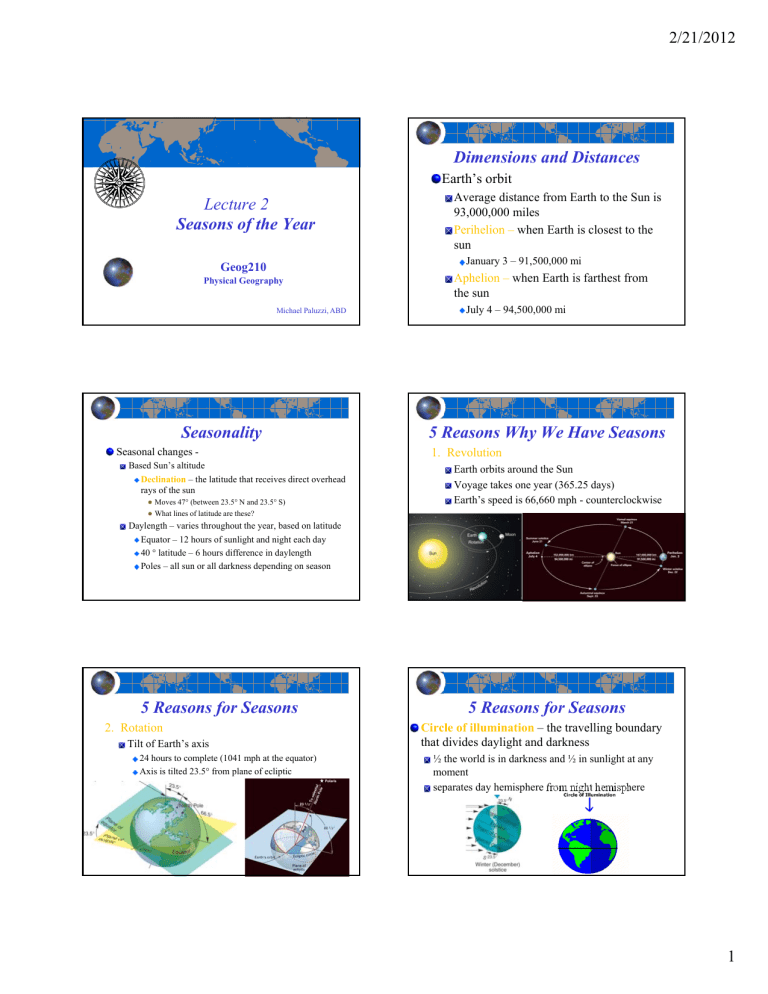
Lecture 2
Seasons of the Year
Geog210
Physical Geography
Michael Paluzzi, ABD
Dimensions and Distances
Earth’s orbit
Average distance from Earth to the Sun is
93,000,000 miles
Perihelion – when Earth is closest to the sun
January 3 – 91,500,000 mi
Aphelion – when Earth is farthest from the sun
July 4 – 94,500,000 mi
2/21/2012
Seasonality
Seasonal changes -
Based Sun’s altitude
Declination – the latitude that receives direct overhead rays of the sun
Moves 47° (between 23.5° N and 23.5° S)
What lines of latitude are these?
Daylength – varies throughout the year, based on latitude
Equator – 12 hours of sunlight and night each day
40 ° latitude – 6 hours difference in daylength
Poles – all sun or all darkness depending on season
5 Reasons Why We Have Seasons
1. Revolution
Earth orbits around the Sun
Voyage takes one year (365.25 days)
Earth’s speed is 66,660 mph - counterclockwise
5 Reasons for Seasons
2. Rotation
Tilt of Earth’s axis
24 hours to complete (1041 mph at the equator)
Axis is tilted 23.5° from plane of ecliptic
5 Reasons for Seasons
Circle of illumination – the travelling boundary that divides daylight and darkness
½ the world is in darkness and ½ in sunlight at any moment separates day hemisphere from night hemisphere
1
5 Reason for Seasons
3. Tilt of Earth’s axis
Axial tilt refers to the tilt of the earth's axis of rotation which is inclined 23.5° degrees
5 Reasons for Seasons
4. Axial parallelism – Earth’s axis is constant during orbit around the Sun (23.5°) axis of the earth remains parallel to it's previous position as the earth revolves around the sun. This means that the earth's axis always points in the same direction – Polaris
2/21/2012
Why do we have seasons?
5. Sphericity - because is a sphere, the length of the sun’s rays are not equal
Longer towards the poles
Subsolar Point – sun’s rays are perpendicular to the surface of the earth
Annual March of the Seasons
Spring Equinox – March 20 or 21
Circle of illumination passes through both poles
All points receive 12 hours of daylight &
12 hours of nighttime
North Pole see first sign of sun since
September equinox
South Pole – sun sets for next six months
Annual March of the Seasons
Summer solstice – June 20 or 21
Subsolar point (Shortest rays of the sun) are over the Tropic of Cancer
Circle of Illumination includes North Polar region - Midnight sun
Antarctic Circle and south =
24 hour darkness
Annual March of the Seasons
Fall equinox – September 22 or 23
Circle of illumination passes through both poles
All points receive 12 hours of daylight &
12 hours of nighttime
South Pole see first sign of sun since March equinox
North Pole – sun sets for next six months
2
Annual March of the Seasons
Winter solstice – December 21 or 22
Circle of illumination excludes the North Pole
24 hours of darkness
C of I – includes the South
Pole
Northern Hemisphere
Tilted away from sun
Lower angle of suns rays
Winter
Southern Hemisphere
Summer
11:30 PM in the Antarctic
Annual March of the Seasons
Seasons of the Year
Earth-Sun Relations
Figure 2.16
2/21/2012
3

